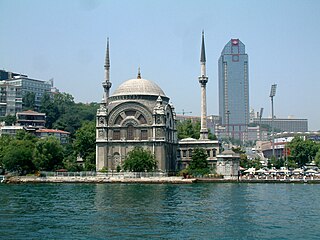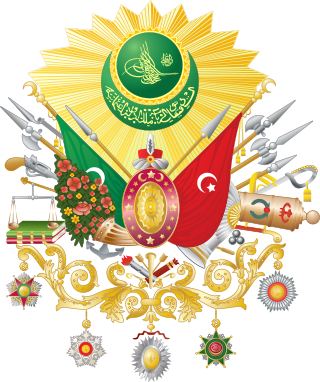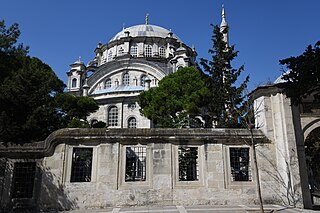
The Blue Mosque, officially the Sultan Ahmed Mosque, is an Ottoman-era historical imperial mosque located in Istanbul, Turkey. It was constructed between 1609 and 1617 during the rule of Ahmed I and remains a functioning mosque today. It also attracts a large number of tourists and is one of the most iconic and popular monuments of Ottoman architecture.

Dolmabahçe Palace located in the Beşiktaş district of Istanbul, Turkey, on the European coast of the Bosporus strait, served as the main administrative center of the Ottoman Empire from 1856 to 1887 and from 1909 to 1922.

Ortaköy is a neighbourhood in the municipality and district of Beşiktaş, Istanbul Province, Turkey. Its population is 9,423 (2022). It is on the European shore of the Bosphorus. it was originally a small fishing village, known in Greek as Agios Fokas in the Byzantine period and then as Mesachorion.

The Selimiye Mosque is an Ottoman imperial mosque, located in the city of Edirne, Turkey. It was commissioned by Sultan Selim II and was built by the imperial architect Mimar Sinan between 1568 and 1575. It was considered by Sinan to be his masterpiece and is one of the highest achievements of Islamic architecture as a whole and Ottoman architecture in particular.

The Balyan family was a prominent Armenian family in the Ottoman Empire of court architects in the service of Ottoman sultans and other members of the Ottoman dynasty during the 18th and 19th centuries. For five generations, they designed and constructed numerous major buildings in the Ottoman Empire, including palaces, mansions, konaks, kiosks, yalis, mosques, churches, and various public buildings, mostly in Constantinople.

Ortaköy Mosque, formally the Büyük Mecidiye Camii in Beşiktaş, Istanbul, Turkey, is a mosque situated at the waterside of the Ortaköy pier square, one of the most popular locations on the Bosphorus. It was commissioned by the Ottoman sultan Abdülmecid I and its construction was completed around 1854 or 1856.

Bezmiâlem Sultan, called also Bazimialam Sultan, was a consort of Sultan Mahmud II, and Valide sultan to their son, Sultan Abdulmecid I of the Ottoman Empire.

The Laleli Mosque is an 18th-century Ottoman imperial mosque located in Laleli, Fatih, Istanbul, Turkey.

The Yeni Valide Mosque is an 18th-century Ottoman mosque in the Üsküdar district of Istanbul, Turkey.

The Pertevniyal Valide Sultan Mosque, also known as the Aksaray Valide Mosque, is a grand Ottoman imperial mosque in Istanbul, Turkey. It is located at the intersection of Ordu Street and Atatürk Boulevard in the Aksaray neighborhood beside the Pertevniyal High School which was also built by the order of Sultana Pertevniyal in 1872. The mosque attracts 400-500 worshipers during regular prayer times and over 2,500 worshipers during Friday prayers.

The architecture of Istanbul describes a large mixture of structures which reflect the many influences that have made an indelible mark in all districts of the city. The ancient part of the city is still partially surrounded by the Walls of Constantinople, erected in the 5th century by Emperor Theodosius II to protect the city from invasion. The architecture inside the city proper contains buildings and structures which came from Byzantine, Genoese, Ottoman, and modern Turkish sources. The city has many architecturally significant entities. Throughout its long history, Istanbul has acquired a reputation for being a cultural and ethnic melting pot. As a result, there are many historical mosques, churches, synagogues, palaces, castles and towers to visit in the city.

The Grand Mosque of Bursa is a historic mosque in Bursa, Turkey. It was commissioned by the Ottoman Sultan Bayezid I to commemorate his great victory at the Battle of Nicopolis and built between 1396 and 1399. The mosque is a major monument of early Ottoman architecture and one of the most important mosques in the city, located in the heart of the old city alongside its historic markets.

The Nuruosmaniye Mosque is an 18th-century Ottoman mosque located in the Çemberlitaş neighbourhood of Fatih district in Istanbul, Turkey, which was inscribed in the Tentative list of World Heritage Sites in Turkey in 2016.

The following outline is provided as an overview of and topical guide to the Ottoman Empire:

The Selimiye Mosque is a mosque in the district of Üsküdar in Istanbul, Turkey, near the Selimiye Barracks. It was commissioned by Ottoman Sultan Selim III and built between 1801 and 1805.

Classical Ottoman architecture is a period in Ottoman architecture generally including the 16th and 17th centuries. The period is most strongly associated with the works of Mimar Sinan, who was Chief Court Architect under three sultans between 1538 and 1588. The start of the period also coincided with the long reign of Suleiman the Magnificent, which is recognized as the apogee of Ottoman political and cultural development, with extensive patronage in art and architecture by the sultan, his family, and his high-ranking officials.

Ottoman Baroque architecture, also known as Turkish Baroque, was a period in Ottoman architecture in the 18th century and early 19th century which was influenced by European Baroque architecture. Preceded by the changes of the Tulip Period and Tulip Period architecture, the style marked a significant departure from the classical style of Ottoman architecture and introduced new decorative forms to mostly traditional Ottoman building types. It emerged in the 1740s during the reign of Mahmud I (1730–1754) and its most important early monument was the Nuruosmaniye Mosque, completed in 1755. Later in the 18th century, new building types were also introduced based on European influences. The last fully Baroque monuments, such as the Nusretiye Mosque, were built by Mahmud II in the early 19th century, but during this period new European-influenced styles were introduced and supplanted the Baroque.

This article covers the history of Ottoman architecture from the 19th century up to the end of the Ottoman Empire in the early 20th century. The 19th century saw an increase of architectural influences from Western Europe in Ottoman culture. The Ottoman Baroque style, which emerged in the 18th century, continued to be evident in the early 19th century under the reigns of Selim III and Mahmud II. Empire style and Neoclassical motifs also began to be introduced around this time. Subsequently, a trend towards eclecticism became prominent in many types of buildings, particularly during the Tanzimat period, as exemplified by the Dolmabaçe Palace and many mosques of this era designed by architects of the Balyan family.































